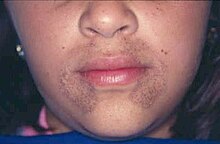Ochronosis
| Classification according to ICD-10 | |
|---|---|
| E70.2 | Disorders of the tyrosine metabolism ochronosis |
| ICD-10 online (WHO version 2019) | |
As ochronosis (ὠχρός from the ancient Greek, bright, light brown), the brown-black pigmentation by deposition of homogentisic - polymers in the skin , the connective tissue and cartilage called. It is a result of autosomal - recessive inherited Alkaptonurie due to a genetic deficiency of the homogentisic acid dioxygenase in the liver and kidney .
Homogentisic acid is an intermediate of the phenylalanine and tyrosine metabolism, and if it is not broken down, it leads to alkaptonuria. Homogentisic acid is excreted via the kidneys, which then oxidize in the air and then turn the urine - especially if it is alkaline - brown-black ("black urine disease"). In the body itself, if there is an excess of homogentisic acid, a polymeric quinoid dye is formed, which penetrates well into collagen-rich tissue and there leads to dark brown discoloration and degeneration . These collagen-rich tissues include:
- Sclera : not clinically bothersome, but a cosmetic problem
- Tendons
- Cartilage : Arthrosis (Osteoarthrosis deformans alcaptonurica)
- Vascular intima : atheromatosis , high blood pressure , arterial occlusive disease , coronary artery disease , stroke
- Auditory ossicles : hearing loss
